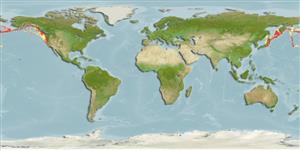Environment: milieu / climate zone / depth range / distribution range
Ecología
marino batidemersal; rango de profundidad 500 - 2800 m (Ref. 50610). Deep-water; 72°N - 34°N, 138°E - 121°W (Ref. 117245)
North Pacific: Japan (Ref. 559) and the Bering Sea to off San Diego, California, USA.
Tamaño / Peso / Age
Maturity: Lm ? range ? - ? cm
Max length : 70.0 cm TL macho / no sexado; (Ref. 2850); peso máximo publicado: 9.5 kg (Ref. 2850)
Short description
Claves de identificación | Morfología | Morfometría
Espinas dorsales (total) : 8; Radios blandos dorsales (total) : 19 - 20; Espinas anales: 0; Radios blandos anales: 12 - 14. Many small cirri scattered on head and body; no preopercular spine; branchiostegal membranes fused to isthmus; peritoneum pale (Ref. 559).
Occurs in very deep waters (Ref. 2850). Feeds on sea pens, crabs and mollusks (Ref. 2850).
Life cycle and mating behavior
Maturities | Reproducción | Spawnings | Egg(s) | Fecundities | Larva
Eschmeyer, W.N., E.S. Herald and H. Hammann, 1983. A field guide to Pacific coast fishes of North America. Boston (MA, USA): Houghton Mifflin Company. xii+336 p. (Ref. 2850)
IUCN Red List Status (Ref. 130435)
Threat to humans
Harmless
Human uses
Pesca deportiva: si
Herramientas
Special reports
Download XML
Fuentes de Internet
Estimates based on models
Preferred temperature (Ref.
123201): 2.3 - 4.8, mean 2.8 °C (based on 265 cells).
Phylogenetic diversity index (Ref.
82804): PD
50 = 0.5005 [Uniqueness, from 0.5 = low to 2.0 = high].
Bayesian length-weight: a=0.00389 (0.00180 - 0.00842), b=3.12 (2.94 - 3.30), in cm total length, based on all LWR estimates for this body shape (Ref.
93245).
Nivel trófico (Ref.
69278): 3.5 ±0.57 se; based on food items.
Fishing Vulnerability (Ref.
59153): Moderate to high vulnerability (48 of 100).
